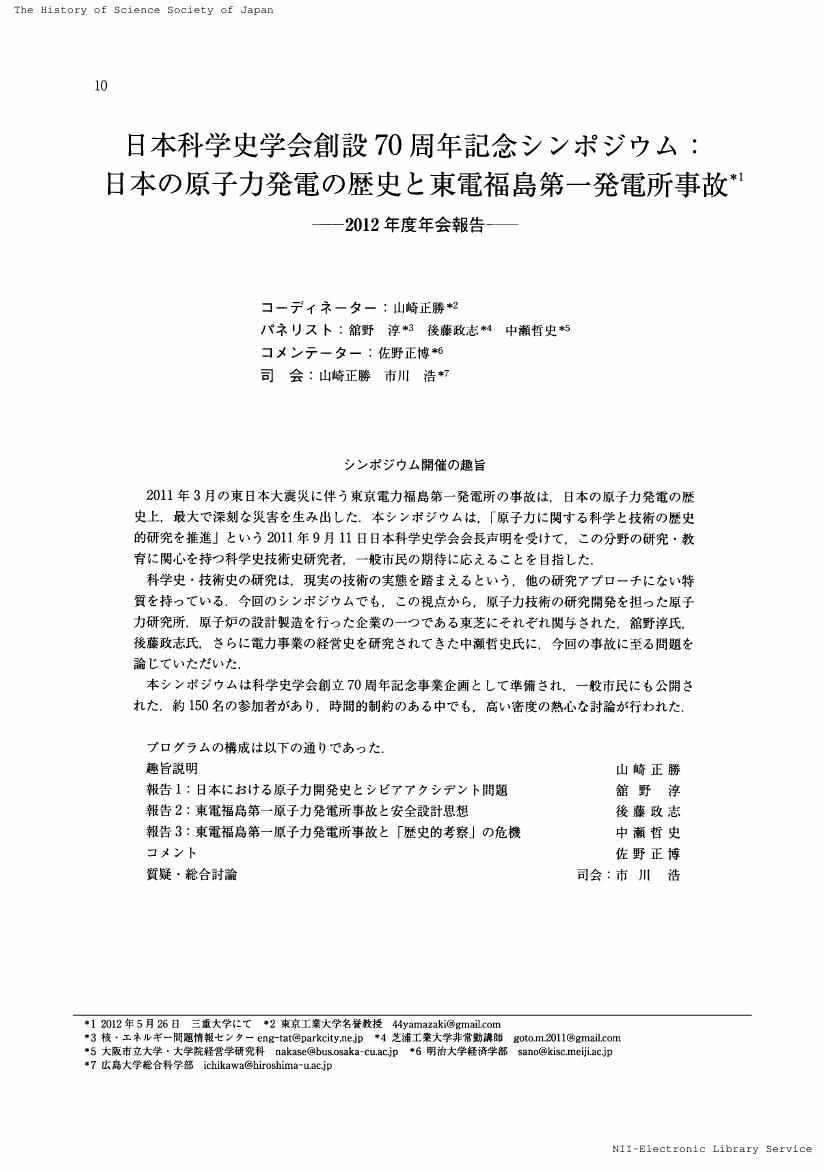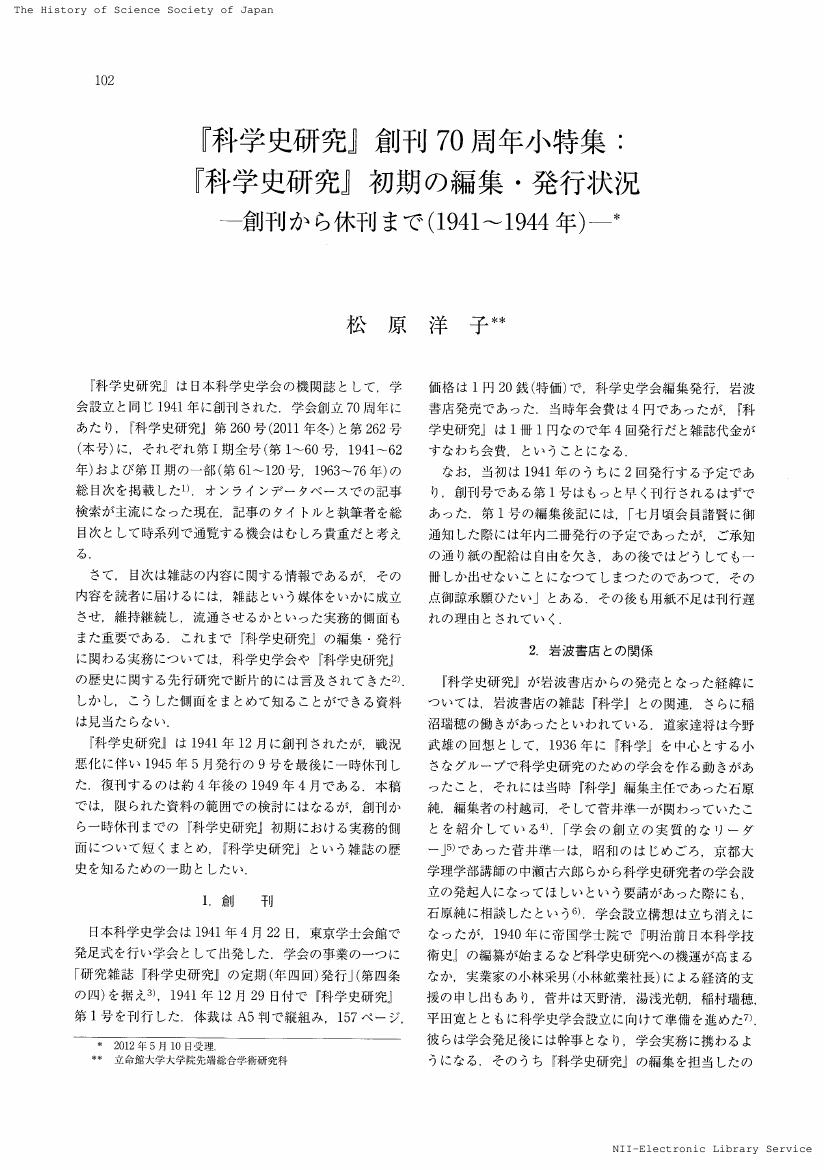1 0 0 0 OA 日本科学史学会創設70周年記念シンポジウム,2012年度年会報告
1 0 0 0 OA プランク共鳴子は原子・分子による光吸収・放出機能のモデル化である
- 著者
- 安孫子 誠也
- 出版者
- 日本科学史学会
- 雑誌
- 科学史研究 (ISSN:21887535)
- 巻号頁・発行日
- vol.52, no.265, pp.5-9, 2013 (Released:2021-07-14)
1 0 0 0 OA 紹介
- 出版者
- 日本科学史学会
- 雑誌
- 科学史研究 (ISSN:21887535)
- 巻号頁・発行日
- vol.51, no.263, pp.181-189, 2012 (Released:2021-07-20)
1 0 0 0 OA 近世日本数学史
- 著者
- 佐藤 賢一
- 出版者
- 日本科学史学会
- 雑誌
- 科学史研究 (ISSN:21887535)
- 巻号頁・発行日
- vol.51, no.264, pp.193-198, 2012 (Released:2021-07-20)
- 著者
- 日野川 静枝
- 出版者
- 日本科学史学会
- 雑誌
- 科学史研究 (ISSN:21887535)
- 巻号頁・発行日
- vol.51, no.264, pp.199-209, 2012 (Released:2021-07-20)
This paper examines the way the University of California's Radiation Laboratory, which was at the center of cyclotron development in the 1930s, became a center of military research for the development of new weapons. Focusing on Alfred Lee Loomis (1887-1975), the author elucidates the nature of his relationship with the Radiation Laboratory from late 1939 through the autumn of 1940. Three points are clarified: 1) Loomis' role in getting a 184-inch cyclotron planned: 2) the significance of his presence as Lawrence's "partner" in getting the actual construction started; and 3) Loomis' role in getting the Radiation Laboratory's microwave research incorporated into the National Defense Research Committee's military research.
1 0 0 0 OA 日中戦争下における基礎研究シフト : 科学研究費交付金の創設
- 著者
- 水沢 光
- 出版者
- 日本科学史学会
- 雑誌
- 科学史研究 (ISSN:21887535)
- 巻号頁・発行日
- vol.51, no.264, pp.210-219, 2012 (Released:2021-07-20)
In 1939, Japan's Ministry of Education established the Subsidiary Fund for Scientific Research, a predecessor to the Grant-in-Aid for Scientific Research (KAKENHI), which supported basic scientific research in Japan. The budget of this Fund was twice the sum of the existing research grants. Even though the Second Sino-Japanese War was in progress, the Ministry of Education emphasized the need for basic scientific research. Previous studies site impact of scientific blockade against Japan or then Minister's influence as main reason for Establishment of the Subsidiary Fund for Scientific Research. However, the ban was not serious in 1939; in fact, from 1936 to 1940, foreign books and magazines were available in Japan. The Ministry of Education had started searching for new ways to promote science and its study well before the change in government. Therefore, the information from previous studies is inadequate. In this paper, the author focuses on the "unsustainable development of applied research" during the Second Sino-Japanese War. When the war started, the scientific community started providing applied research in response to wartime demands. Scientists started working towards allaying the shortage in natural resources and military material that had been brought about by the economic block against Japan. It became obvious then that a lack of talented scientists, scientific facilities, and research funds were hindering the progress of applied research. Scientists started asking the Ministry of Education to swiftly employ measures to promote science. This resulted in the Ministry establishing the Subsidiary Fund for Scientific Research. In prewar Japan, the environment for academic research was very poor; due to this, a single-minded focus on applied research was unsustainable.
1 0 0 0 OA 中根元圭の『新撰古暦便覧』と漢訳系西洋天文・暦学書(アゴラ)
- 著者
- 小林 龍彦
- 出版者
- 日本科学史学会
- 雑誌
- 科学史研究 (ISSN:21887535)
- 巻号頁・発行日
- vol.51, no.264, pp.220-225, 2012 (Released:2021-07-20)
1 0 0 0 OA 2012年地球惑星科学連合大会における科学史関係セッションの報告(アゴラ)
- 著者
- 矢島 道子
- 出版者
- 日本科学史学会
- 雑誌
- 科学史研究 (ISSN:21887535)
- 巻号頁・発行日
- vol.51, no.264, pp.226-228, 2012 (Released:2021-07-20)
1 0 0 0 OA 第59回日本科学史学会年会・総会報告
- 出版者
- 日本科学史学会
- 雑誌
- 科学史研究 (ISSN:21887535)
- 巻号頁・発行日
- vol.51, no.263, pp.174-180, 2012 (Released:2021-07-20)
1 0 0 0 OA 活力論争を解消する18世紀の試み
- 著者
- 有賀 暢迪
- 出版者
- 日本科学史学会
- 雑誌
- 科学史研究 (ISSN:21887535)
- 巻号頁・発行日
- vol.51, no.263, pp.160-169, 2012 (Released:2021-07-20)
In his classical article "Eighteenth-century attempts to resolve the vis viva controversy" (1965), T. L. Hankins gave a reassessment of the vis viva controversy, dispute about the Cartesian (mv) and Leibnizian (mv^2) measures of "force." Contrary to traditional views, Hankins's and others' works have established that it was not d'Alembert's Traite de dynamique (1743) which put an end to the controversy. But then, when and how did it end? The present article argues that in the middle of the eighteenth-century, some philosophers or mathematicians tried to dissolve the controversy by rejecting its very premise: the concept of "force of bodies in motion." After briefly discussing the popularity of this concept in the vis viva controversy, I will examine claims and thoughts of three personae. D'Alembert's ambition to build the system of mechanics with highest certainty led him to abandon the idea of force in bodies, because it was too "obscure" and too "metaphysical" to serve as the basis. In a similar manner Maupertuis complained about the obscurity of that idea, and with his original principle he aimed at substituting "conservation" of force for "least" action. With regard to Euler, he insisted that force could not be attributed to individual bodies but to their relations, and that force was derived from the nature of bodies such as inertia or impenetrability. Thus it was by rejecting "force of bodies in motion" that the vis viva controversy began to end; not by, as is often said, realizing that both measures were valid.
- 著者
- 松原 洋子
- 出版者
- 日本科学史学会
- 雑誌
- 科学史研究 (ISSN:21887535)
- 巻号頁・発行日
- vol.51, no.262, pp.102-105, 2012 (Released:2021-07-20)
- 著者
- 石山 洋
- 出版者
- 日本科学史学会
- 雑誌
- 科学史研究 (ISSN:21887535)
- 巻号頁・発行日
- vol.51, no.262, pp.95-101, 2012 (Released:2021-07-20)
1 0 0 0 OA イブン・シーナーの自然精気
- 著者
- 矢口 直英
- 出版者
- 日本科学史学会
- 雑誌
- 科学史研究 (ISSN:21887535)
- 巻号頁・発行日
- vol.51, no.263, pp.129-137, 2012 (Released:2021-07-20)
It is often stated that physicians in medieval Islam followed Galen in assuming that there were three kinds of pneumata (psychic, vital and natural) in human beings. This article examines the concept of the third kind of pneuma, the natural pneuma (ruh tabi i), in the medical theory of Ibn Sina (d. 1037). The examination of his medical works reveals that while Ibn SinS had some clear ideas about the workings of the vital and psychic pneumata, he proposed no definite theory of the natural pneuma. He refers only very rarely to the natural pneuma in his Canon of Medicine, Poem of Medicine and On Cardiac Medicaments, and in those few instances the natural pneuma is explained simply as being parallel to the other two pneumata in that it has its seat in a specific organ, is distributed through a specific passage, and gives rise to a specific faculty, namely that it is located in the liver, travels through veins, and gives rise to the natural faculty, just as the vital pneuma, with its source in the heart, travels through the arteries to give rise to the vital faculty, and the psychic pneuma, with its source in the brain, travels through the nerves to give rise to the psychic faculty. In sum, in the medical thought of Ibn Sina, the natural pneuma exists merely as a parallel to the other two pneumata, so as to ensure the existence of a triadic system in the human body.
1 0 0 0 OA 工学会の成立 : 工部大学校同窓会から学会へ
- 著者
- 和田 正法
- 出版者
- 日本科学史学会
- 雑誌
- 科学史研究 (ISSN:21887535)
- 巻号頁・発行日
- vol.51, no.263, pp.148-159, 2012 (Released:2021-07-20)
The first 23 graduates of the Imperial College of Engineering in Tokyo, or Kobu-Daigakko, founded the Society of Engineering, or Kogakkai, in 1879 as an alumni association. After 1882, the society began allowing other engineers to become regular members. This paper discusses the process how this private organization turned into a public society by uncovering the detail of its early history: establishment; formation of the rule, meetings, the bulletin and journal; registration of other engineers; and the role of Yozo Yamao. Initially, the leading members had been doing only administrative works at the monthly meetings, such as collecting membership fees and revising the rules. The members gradually began holding seminars on industrial and engineering topics. In 1880, they began circulating a bulletin, Kogaku Soshi(later Kogakkai-shi), for the members, and printed eight issues. In response to the requests of non-members, they published the bulletin publicly the following year. In 1882, the society asked a prominent leading figure of engineering Yozo Yamao, one of the co-founders of the Imperial College of Engineering, to be president. Yamao did not engage in any activities while he was president, but he played a role, as a representative, in giving the society wider legitimacy in the engineering world. The early history of the society indicates that the graduates of the College took an active part in the academic field of engineering. Within two years of the 23 members graduating, they made the society a leader in the underdeveloped community of late 19th-century Japan.
1 0 0 0 OA 第6回日本科学史学会賞の報告
- 出版者
- 日本科学史学会
- 雑誌
- 科学史研究 (ISSN:21887535)
- 巻号頁・発行日
- vol.51, no.263, pp.170-173, 2012 (Released:2021-07-20)
1 0 0 0 OA 東日本大震災以後の被災地史料の保存に対する雑感(アゴラ)
- 著者
- 佐藤 賢一
- 出版者
- 日本科学史学会
- 雑誌
- 科学史研究 (ISSN:21887535)
- 巻号頁・発行日
- vol.51, no.261, pp.47-49, 2012 (Released:2021-07-20)
1 0 0 0 OA 間重富の『暦象考成後編』入手をめぐって(アゴラ)
- 著者
- 嘉数 次人
- 出版者
- 日本科学史学会
- 雑誌
- 科学史研究 (ISSN:21887535)
- 巻号頁・発行日
- vol.51, no.261, pp.50-53, 2012 (Released:2021-07-20)
1 0 0 0 OA 紹介
- 出版者
- 日本科学史学会
- 雑誌
- 科学史研究 (ISSN:21887535)
- 巻号頁・発行日
- vol.51, no.261, pp.54-61, 2012 (Released:2021-07-20)
1 0 0 0 OA イブン・スィーナー著『心臓の薬』におけるプネウマ理論
- 著者
- 俵 章浩
- 出版者
- 日本科学史学会
- 雑誌
- 科学史研究 (ISSN:21887535)
- 巻号頁・発行日
- vol.51, no.262, pp.65-73, 2012 (Released:2021-07-20)
The purpose of this paper is to analyse the concept of pneuma (ruh) in On Cardiac Drugs, a medical work of Ibn Sina (980-1037). The idea of pneuma, the concept used to explain the physiology of the human body, originated in ancient Greece. Ibn Sina inherited this idea and gave it an important role in his medical theory. In his Canon of Medicine, the Galenic pneuma theory is expounded. In On Cardiac Drugs, by contrast, a property that cannot be explained by Galenic medicine is attributed to pneuma. It is a property of luminosity (nuraniyah), and moreover, luminous pneuma is said to resemble the substance of heaven (jawhar al-sama). This thought is neither found in works of ancient Greek medicine nor in the works of Arabic writers who played a role in introducing Greek medicine to the Arabic world.













